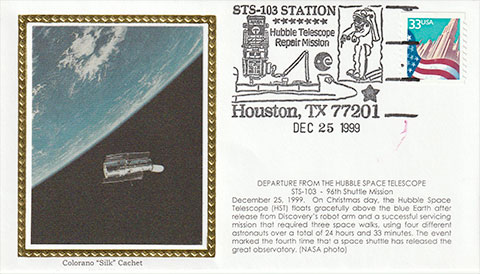Space Cover 783: STS-103 vs. Y2KThe cover above was postmarked in Houston on December 25, 1999, as the STS-103 crew released the Hubble Space Telescope at the completion of Hubble Servicing Mission 3A. It's not a rare cover, but exemplifies the "horse race" that was Hubble Servicing Mission 3A…
Twenty-five years ago, the world was on-edge about the year change from 1999 to 2000, known colloquially as "Y2K". Back then, most computer code had been written using "19__" as the current year. What would happen when the year rolled around to 2000-something? There was a major (repeat major) effort to modify all the computer programs across the world to accept the 2000-something dates. And surrounding all this major (repeat again, major) effort were lots of gloom-and-doom predictions about computer systems crashing due to Y2K, shutting down the power grid, the economy, and even space missions.
Well, NASA, having worked ahead on Y2K, had made modifications to all their computer programs to accept 2000-something dates. But what if something got missed? Nobody at NASA wanted to be flying people in the Space Shuttle over the Y2K date change just in case.
Enter Hubble Servicing Mission 3! Originally scheduled as a "preventative maintenance" mission to be launched in June, 2000, it suddenly got accelerated when Hubble suffered three gyroscope failures (the gyros point the telescope). Suddenly it was time to focus onto an accelerated Servicing Mission 3A as a gyro-replacement mission, which meant throwing some of the original Servicing Mission 3 objectives over to a Servicing Mission 3B (later STS-109). And just to increase the launch pressure, a fourth Hubble gyro failed on November 13, 1999, putting Hubble into safe mode (e.g. – no science happening).
STS-103 on the Shuttle Discovery with Servicing Mission 3A aboard had already been delayed twice during October and November of 1999 due to late-breaking Shuttle wiring inspections needed after STS-93. Finally STS-103 was ready to launch on December 2. But the mission went through seven more launch delays throughout the month, with the desire not to fly over Y2K looming up as a hard-stop at the end of the month. Finally the mission launched on December 19! On December 22, astronauts Steve Smith and John Grunsfeld successfully replaced all six gyros on Hubble along with other servicing mission objectives. And two further spacewalks provided even more upgrades to Hubble, leading the crew to release the observatory on December 25 (the cover above). Two days later, STS-103 was back on the ground, having successfully fixed Hubble AND averting Y2K...
Also, STS-103 was the third US space mission flown over Christmas. The other two are described here.












